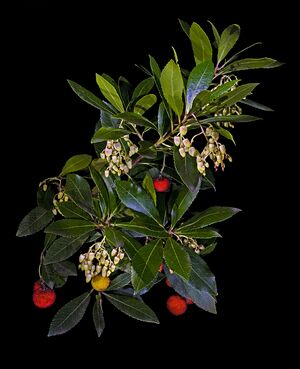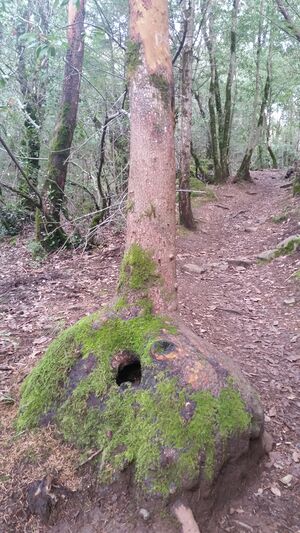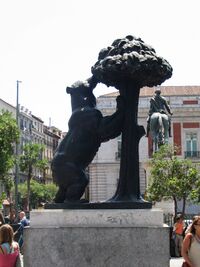قطلب
| قطلب | |
|---|---|

| |
| Arbutus unedo | |
| التصنيف العلمي | |
| أصنوفة غير معروفة (أصلحها): | Arbutus |
| Type species | |
| Arbutus unedo L. 1753
| |
| Species | |
|
See text | |
Arbutus is a genus of 12 accepted species[2] of flowering plants in the family Ericaceae,[3] native to warm temperate regions of the Mediterranean, western Europe, the Canary Islands and North America. The name Arbutus was taken from Latin, where it referred to Arbutus unedo.[4]
الوصف
Arbutus are small trees or shrubs with red flaking bark and edible red berries.[5] Fruit development is delayed for about five months after pollination, so that flowers appear while the previous year's fruit are ripening.[5] Peak flowering for the genus is in April with peak fruiting in October.[6]
التاريخ
The smooth wood of the tree is mentioned by Theophrastus in his Enquiry into Plants (Historia Plantarum) as formerly being used to make weaving spindles. An article on Arbutus tree cultivation in al-Andalus is brought down in Ibn al-'Awwam's 12th-century agricultural work, Book on Agriculture.[7]
الأسماء الشائعة

Members of the genus are called madrones or madronas in the United States, from the Spanish name madroño (strawberry tree). On the south coast of British Columbia, Canada, where the species is common, arbutus is commonly used or, rarely and locally, "tick tree".[8][9] All refer to the same species, Arbutus menziesii, native to the Pacific Northwest and Northern and Central California regions. It is Canada's only native broadleaved evergreen tree. Some species in the genera Epigaea, Arctostaphylos and Gaultheria were formerly classified in Arbutus. As a result of its past classification, Epigaea repens (mayflower) has an alternative common name of "trailing arbutus".
نظاميات
A study published in 2001 which analyzed ribosomal DNA from Arbutus and related genera suggests that Arbutus is paraphyletic and the Mediterranean Basin species of Arbutus are more closely related to Arctostaphylos, Arctous, Comarostaphylis, Ornithostaphylos and Xylococcus than to the western North American species of Arbutus, and that the split between the two groups of species occurred at the Paleogene/Neogene boundary.[10] The 12 species are as follows:[2]
أفرو-أوراسيا
- Arbutus andrachne L. – Greek strawberry tree (Southeastern Europe and southwestern Asia)
- Arbutus canariensis Duhamel – Canary madrone (Canary Islands)
- Arbutus pavarii Pampan. (Libya)
- Arbutus unedo L. – strawberry tree (Mediterranean Basin, western France, and western Ireland)[11]
الأمريكتان
- Arbutus arizonica (A.Gray) Sarg. – Arizona madrone (New Mexico, Arizona and western Mexico south to Jalisco)
- Arbutus bicolor S. González, M. González et P. D. Sørensen (Mexico)
- Arbutus madrensis M. González – western Mexico
- Arbutus menziesii Pursh – Pacific madrone (West coast of North America from southern British Columbia to central (less frequently southern) California, on the west slopes of the Sierra Nevada and Pacific Coast Range mountains)
- Arbutus mollis Kunth (Mexico)
- Arbutus occidentalis McVaugh & Rosatti - western Mexico
- Arbutus tessellata (Mexico)[12]
- Arbutus xalapensis Kunth (syn. A. texana, A. glandulosa, A. peninsularis) – Texas madrone (Texas, New Mexico and northeastern Mexico)[11]
الهجائن
- Arbutus × andrachnoides Link (A. andrachne × A. unedo):[11] this hybrid has gained the Royal Horticultural Society's Award of Garden Merit.[13]
- Arbutus × androsterilis (A. canariensis × A. unedo) in Canary Islands [14]
- Arbutus × thuretiana Demoly (A. andrachne × A. canariensis)
- Arbutus × reyorum [ (A. andrachne × A. canariensis) × A. unedo ]
أنواع كان مصنفة هنا
- Arctostaphylos tomentosa (Pursh) Lindl. (as A. tomentosa Pursh)
- Arctostaphylos uva-ursi (L.) Spreng. (as A. uva-ursi L.)
- Comarostaphylis discolor (Hook.) Diggs (as A. discolor Hook.)
- Gaultheria phillyreifolia (Pers.) Sleumer (as A. phillyreifolia Pers.)[11]
التاريخ الطبيعي
Arbutus species are used as food plants by some Lepidoptera species including emperor moth, Pavonia pavonia and the madrone butterfly.[15] The distribution of the latter species is in fact heavily affected by the distribution of the madrone.[15] For Athenaios, it is the tree which Asclepiades of Myrlea talks about (Deiphnosophists, II.35)
الاستخدامات والرمزية

Several species are widely cultivated as ornamental plants outside of their natural ranges, though cultivation is often difficult due to their intolerance of root disturbance. The hybrid Arbutus 'Marina' is much more adaptable and thrives under garden conditions.
The Arbutus unedo tree makes up part of the coat of arms (El oso y el madroño, The Bear and the Strawberry Tree) of the city of Madrid, Spain. A statue of a bear eating the fruit of the madroño tree stands in the center of the city (Puerta del Sol). The image appears on city crests, taxi cabs, man-hole covers, and other city infrastructure.
The Arbutus was important to the Straits Salish people of Vancouver Island, who used arbutus bark and leaves to create medicines for colds, stomach problems, and tuberculosis, and as the basis for contraceptives. The tree also figured in myths of the Straits Salish.[16]
The fruit is edible but has minimal flavour and is not widely eaten. In Portugal, the fruit is sometimes distilled (legally or not) into a potent brandy known as medronho. In Madrid, the fruit is distilled into madroño, a sweet, fruity liqueur.
Arbutus is a good fuelwood tree since it burns hot and long. Many Pacific Northwest states in the United States use the wood of A. menziesii primarily as a heat source,[بحاجة لمصدر] as the wood holds no value in the production of homes since it does not grow in straight timbers.
"My love's an arbutus" is the title of a poem by the Irish writer Alfred Perceval Graves (1846–1931), set to music by his compatriot Charles Villiers Stanford (1852–1924)
The Canadian songwriter, singer and painter Joni Mitchell (born 1943), includes a reference to the "arbutus rustling" in her song, "For The Roses". It sounded like applause. She calls the arbutus tree her "favorite all-time tree". She had one outside her door in a house she built.
الأهمية الثقافية
According to the Straits Salish, an anthropomorphic form of pitch would go fishing, but return to shore before it got too hot. One day he was too late getting back to shore and melted from the heat and several anthropomorphic trees rushed to get him – the first was Douglas fir, who took most of the pitch, the grand fir received a small portion, and the madrone received none – which is why they say it still has no pitch.
Also, according to the Great Flood legends of several bands in the northwest, the madrone helped people survive by providing an anchor on top of a mountain. Because of this the Saanich people do not burn madrone out of thanks for saving them.[17]
معرض صور
The hybrid Arbutus × andrachnoides
انظر أيضاً
- Myrica rubra, a different plant bearing a similar fruit, whose name is sometimes inaccurately translated from Chinese as Arbutus
المراجع
- ^ "Genus: Arbutus L." Germplasm Resources Information Network. United States Department of Agriculture. 2003-06-04. Retrieved 2012-04-17.
- ^ أ ب Act. Bot. Mex no.99 Pátzcuaro abr. 2012. Arbutus bicolor
- ^ "The plant list, Arbutus". Royal Botanic Garden, Kew.
- ^ Quattrocchi, Umberto (2000). CRC World Dictionary of Plant Names. Vol. I: A–C. CRC Press. p. 182. ISBN 978-0-8493-2675-2.
- ^ أ ب Mabberley, D. J. 1997. The plant book: A portable dictionary of the vascular plants. Cambridge University Press, Cambridge.
- ^ "Arbutus – iNaturalist". Retrieved 9 Nov 2017.
- ^ Ibn al-'Awwam, Yaḥyá (1864). Le livre de l'agriculture d'Ibn-al-Awam (kitab-al-felahah) (in الفرنسية). Translated by J.-J. Clement-Mullet. Paris: A. Franck. pp. 233–234 (ch. 7 – Article 8). OCLC 780050566. (pp. 233–234 (Article VIII)
- ^ Pojar, Jim; Andy MacKinnon (1994). Plants of Coastal British Columbia. Vancouver: Lone Pine Publishing. p. 49. ISBN 978-1-55105-042-3.
- ^ Francis, Daniel (2000). The Encyclopedia of British Columbia (2nd ed.). Madeira Park, BC: Harbour Publishing. p. 20. ISBN 978-1-55017-200-3.
- ^ Hileman, Lena C.; Vasey, Michael C.; Parker, V. Thomas (2001). "Phylogeny and Biogeography of the Arbutoideae (Ericaceae): Implications for the Madrean-Tethyan Hypothesis". Systematic Botany. 26 (1): 131–143. doi:10.1043/0363-6445-26.1.131 (inactive 31 July 2022). JSTOR 2666660.
{{cite journal}}: CS1 maint: DOI inactive as of يوليو 2022 (link) - ^ أ ب ت ث "GRIN Species Records of Arbutus". Germplasm Resources Information Network. United States Department of Agriculture. Retrieved 2012-04-17.
- ^ Paul D. Sørensen 1987. Arbutus tessellata (Ericaceae), new from Mexico Brittonia, 39(2):263–267.
- ^ "RHS Plantfinder – Arbutus × andrachnoides". Royal Horticultural Society. Retrieved 12 January 2018.
- ^ Pascual, M. Salas; Acebes Ginovés, J. R.; Del Arco Aguilar, M. (1993). "RHS Plantfinder - Arbutus × androsterilis, a New Interspecific Hybrid between A. canariensis and A. unedo from the Canary Islands". Taxon. Royal Horticultural Society. 42 (4): 789–792. doi:10.2307/1223264. JSTOR 1223264.
- ^ أ ب P. G., Kevan; R. A., Bye (1991). "natural history, sociobiology, and ethnobiology of Eucheira socialis Westwood (Lepidoptera: Pieridae), a unique and little-known butterfly from Mexico". Entomologist (in الإنجليزية). ISSN 0013-8878. S2CID 90641218.
- ^ Pojar and MacKinnon, 49
- ^ Plants of the Pacific Northwest Coast: Washington, Oregon, British Columbia & Alaska, Paul Alaback, ISBN 978-1-55105-530-5
- Hileman, Lena C.; Vasey, Michael C.; Thomas Parker, V. (2001). "Phylogeny and Biogeography of the Arbutoideae (Ericaceae): Implications for the Madrean-Tethyan Hypothesis". Systematic Botany. 26 (1): 131–143. doi:10.1043/0363-6445-26.1.131 (inactive 31 July 2022). JSTOR 2666660.
{{cite journal}}: CS1 maint: DOI inactive as of يوليو 2022 (link)







